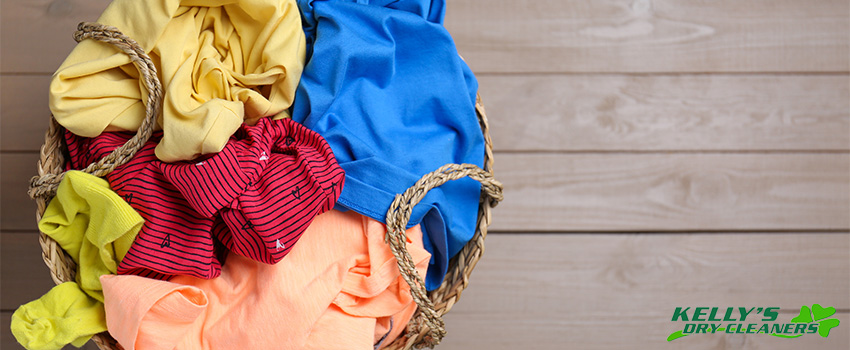Laundry, in general, may seem like a normal part of your daily chores. However, it does come with specific guidelines for a healthy routine. Part of these guidelines involves dry cleaning special fabrics at home.
Contrary to what its name implies, dry cleaning is not actually “dry.” Instead of getting your clothes wet with water, you use perchloroethylene (or “perc”) – or other chemicals that unfortunately end up in our waterways – along with heat and steam to clean clothing and fabrics. Because of this, there are workplace hazards that dry cleaners need to handle to avoid future accidents.
However, not all hope is lost! – There are specific laundry tips that you can utilize to start an eco-friendly dry cleaning at home.
That is why our team at Kelly’s Dry Cleaners would like to share with you some helpful clothing care tips to help you practice laundry safety and efficient dry cleaning.
1. Always Check the Label
First things first, always read your clothing labels. If you happen to see tags on your items that indicate “dry clean only,” then consider going to a professional dry cleaner like KDC. Hand- or machine-washing may only cause damage to your garment.
However, care labels that say “dry clean” may allow you to do dry cleaning at home. To do this, check that the fabric is colorfast before washing the item. You can pat some water on an inconspicuous spot. If you see any dye coming off, you can proceed with dry cleaning as the color can cause the fabric to run, leading to damage.
2. Know Your Fabric
Always consider the item’s fabric; only certain types benefit more from dry cleaning. Materials that are not colorfast and shrink, such as lined jackets, garments, and pleated skirts, require professional cleaning.
There are special fibers, fabric, textures, and garments that require professional dry cleaning. Among these are: silk, wool, velvet, acetate, rayon, and taffeta.
3. Prepare Your Clothes
Before putting harsh chemicals on your clothing:
- Verify that all of them are in good shape and that nothing of value is inside your pockets.
- Avoid leaving items such as gum and makeup, as this can damage the clothes inside the washer.
- Make sure to dry-clean the separate clothing, such as ties and suits, together.
If you’re considering taking them out for professional cleaning, make stains easy to spot by using pins or tape near the stain. Another important laundry tip is to inform the dry cleaners about the origin of the stain and what specific services you like to avoid guesswork.
4. Use Dry-Cleaning Products Properly
There are at-home dry-cleaning kits that you can purchase as an alternative and cheaper option to dry cleaning, but they are designed for spot-cleaning and deodorizing. Most kits work with a standard dryer and function by steaming the clothing; some work differently from others. So, make sure to read the clothing care instructions found in these products.
Plus, with the high efficiency of washing machines nowadays, there is no need to use too much detergent. You can remove spots with temperature and early treatment. On the one hand, bleach only removes the spot’s colors and not the spot itself. When using bleach, make sure that you only use a drop of it on the area and rinse it off immediately.
5. Avoid Using Cold Water
One essential clothing care tip would be to steer clear from using cold water when it comes to dry cleaning. Cold water contributes to colorfastness and the possible risk of shrinkage. Note that dry cleaning often involves hot, humid environments, which have been proven to remove stains more effectively.
For instance, steam washers can go up to temperatures reaching as high as 212 degrees Fahrenheit to eliminate tough stains. Concerning equipment like this, make sure also to label them with warning signs.
6. Try Tennis Balls
Throwing tennis balls with loads like comforters, blankets, and puffer jackets can help ensure that the filling inside is evenly distributed when dry cleaning is complete. Plus, an individual named Kelli Anderson shared that tennis balls inside dryers can help fluff up the down after it gets wet. Just verify that no one is sleeping while doing so, as this can be a bit loud and “bouncy.”
7. Consider Making Your Own Dry-Cleaning Recipe
Yes, it’s possible! Usually, this is used to eliminate stains for a spot-clean finish. Dry cleaners often use their own recipe for stain removers and spot cleaning solutions. This technique usually contains highly concentrated PERC and other unknown chemicals.
You can combine a little water and Ajax on the spot for your DIY solution and rub the stain out using a clean part of the fabric. Afterward, create a dry-cleaning mix. An example can be from a fashion designer named Angelina McCullar, which is composed of:
- 1 cup of warm water
- ¼ cup vinegar
- 1 teaspoon of Borax
- 1 teaspoon of oxygen bleach
- Few drops of lavender
There you have it! We hope these tips can help you with your next DIY dry cleaning project. Remember, there are some stains and dry-cleaning practices that only experts can adequately handle. If you need help with your dry-cleaning needs, or if you have any inquiries, you may contact us at 970-903-1642 or visit our Green earth cleaner in Durango.



